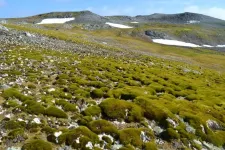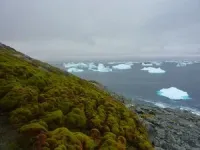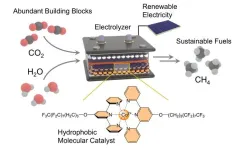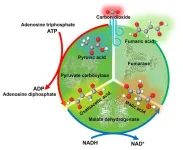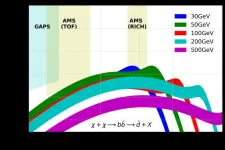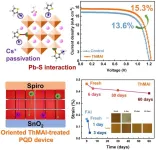(Press-News.org) Vegetation cover across the Antarctic Peninsula has increased more than tenfold over the last four decades, new research shows.
The Antarctic Peninsula, like many polar regions, is warming faster than the global average, with extreme heat events in Antarctica becoming more common.
The new study – by the universities of Exeter and Hertfordshire, and the British Antarctic Survey – used satellite data to assess how much the Antarctic Peninsula has been “greening” in response to climate change.
It found that the area of vegetation cover across the Peninsula increased from less than one square kilometre in 1986 to almost 12 square kilometres by 2021.
Published in the journal Nature Geoscience, the study also found this greening trend accelerated by over 30% in recent years (2016-2021) relative to the full study period (1986-2021) – expanding by over 400,000 square metres per year in this period.
In a previous study, which examined core samples taken from moss-dominated ecosystems on the Antarctic Peninsula, the team found evidence that rates of plant growth had increased dramatically in recent decades.
This new study uses satellite imagery to confirm that a widespread greening trend, across the Antarctic Peninsula, is under way and accelerating.
“The plants we find on the Antarctic Peninsula – mostly mosses – grow in perhaps the harshest conditions on Earth,” said Dr Thomas Roland, from the University of Exeter.
“The landscape is still almost entirely dominated by snow, ice and rock, with only a tiny fraction colonised by plant life.
“But that tiny fraction has grown dramatically – showing that even this vast and isolated ‘wilderness’ is being affected by anthropogenic climate change.”
Dr Olly Bartlett, from the University of Hertfordshire, added: “As these ecosystems become more established – and the climate continues to warm – it’s likely that the extent of greening will increase.
“Soil in Antarctica is mostly poor or non-existent, but this increase in plant life will add organic matter, and facilitate soil formation – potentially paving the way for other plants to grow.
“This raises the risk of non-native and invasive species arriving, possibly carried by eco-tourists, scientists or other visitors to the continent.”
The researchers emphasise the urgent need for further research to establish the specific climate and environmental mechanisms that are driving the “greening” trend.
“The sensitivity of the Antarctic Peninsula’s vegetation to climate change is now clear and, under future anthropogenic warming, we could see fundamental changes to the biology and landscape of this iconic and vulnerable region,” said Dr Roland.
He added: “Our findings raise serious concerns about the environmental future of the Antarctic Peninsula, and of the continent as a whole. In order to protect Antarctica, we must understand these changes and identify precisely what is causing them.”
The researchers are now investigating how recently deglaciated (ice-free) landscapes are colonised by plants, and how the process might proceed into the future.
The paper is entitled: “Satellites evidence sustained greening of the Antarctic Peninsula.”
END
Antarctic ‘greening’ at dramatic rate
2024-10-04
ELSE PRESS RELEASES FROM THIS DATE:
Winds of change: James Webb Space Telescope reveals elusive details in young star systems
2024-10-04
Every second, more than 3,000 stars are born in the visible universe. Many are surrounded by what astronomers call a protoplanetary disk – a swirling "pancake" of hot gas and dust from which planets form. The exact processes that give rise to stars and planetary systems, however, are still poorly understood.
A team of astronomers led by University of Arizona researchers has used NASA's James Webb Space Telescope to obtain some of the most detailed insights into the forces that shape protoplanetary disks. The observations offer glimpses into what our solar system may have looked like 4.6 billion years ago.
Specifically, the team was able to trace so-called ...
UC Merced co-leads initiative to combat promotion and tenure bias against Black and Hispanic faculty
2024-10-04
Black and Hispanic faculty members seeking promotion at research universities face career-damaging biases, with their scholarly production judged more harshly than that of their peers, according to a groundbreaking initiative co-led by the University of California, Merced that aims to uncover the roots of these biases and develop strategies for change.
Junior professors are generally evaluated and voted on for promotion and tenure by committees comprising senior colleagues. In one of the studies conducted by the research team, results suggest that faculty from underrepresented minorities received 7% more negative votes from ...
Addressing climate change and inequality: A win-win policy solution
2024-10-04
Climate change and economic inequality are deeply interconnected, with the potential to exacerbate each other if left unchecked. A new study published in Nature Climate Change sheds light on this critical relationship using data from eight large-scale Integrated Assessment Models (IAMs) to examine the distributional impacts of climate policies and climate risks. The study provides robust evidence that climate policies aligned with the Paris Agreement can mitigate long-term inequality while addressing climate change.
Led by Johannes Emmerling, Senior Scientist at the Euro-Mediterranean ...
Innovative catalyst produces methane using electricity
2024-10-04
Researchers at the University of Bonn and University of Montreal have developed a new type of catalyst and used it in their study to produce methane out of carbon dioxide and water in a highly efficient way using electricity. Methane can be used, for example, to heat apartments or as a starting material in the chemical industry. It is also the main component of natural gas. If it is produced using green electricity, however, it is largely climate neutral. The insights gained from the model system studied by the researchers can be transferred to large-scale technical ...
Liver X receptor beta: a new frontier in treating depression and anxiety
2024-10-04
Houston, Texas – In a state-of-the-art Bench to Bedside review published in the journal Brain Medicine (Genomic Press), researchers Dr. Xiaoyu Song and Professor Jan-Åke Gustafsson from the University of Houston and Karolinska Institutet (Sweden) shed light on the therapeutic potential of liver X receptor beta (LXRβ) in treating depression and anxiety. This comprehensive analysis marks a significant step forward in understanding the molecular underpinnings of mental health disorders and potentially revolutionizing their treatment.
LXRβ, a nuclear receptor initially known for its role in cholesterol metabolism and inflammation, is now emerging as a crucial ...
Improving fumaric acid production efficiency through a ‘more haste, less speed’ strategy
2024-10-04
As plastic waste continues to build up faster than it can decompose, the need for biodegradable solutions is evident.
Previously, Professor Yutaka Amao and his team at Osaka Metropolitan University’s Research Center for Artificial Photosynthesis succeeded in synthesizing fumaric acid, a raw material for biodegradable plastics from biomass-derived pyruvic acid and carbon dioxide. However, the fumaric acid production process reported earlier has a problem with producing undesirable substances as byproducts in addition to L-malic acid, which is ...
How future heatwaves at sea could devastate UK marine ecosystems and fisheries
2024-10-04
The oceans are warming at an alarming rate. 2023 shattered records across the world’s oceans, and was the first time that ocean temperatures exceeded 1oC over pre-industrial levels. This led to the emergence of a series of marine heatwave events across both hemispheres, from the waters around Japan, around South America, and across the wider North Atlantic. Marine heatwaves are periods of extremely warm sea temperatures that can form in quite localized hot spots but also span large parts of ocean ...
Glimmers of antimatter to explain the "dark" part of the universe
2024-10-04
One of the great challenges of modern cosmology is to reveal the nature of dark matter. We know it exists (it constitutes over 85% of the matter in the Universe), but we have never seen it directly and still do not know what it is. A new study published in JCAP has examined traces of antimatter in the cosmos that could reveal a new class of never-before-observed particles, called WIMP (Weakly Interacting Massive Particles), which could make up dark matter. The study suggests that some recent observations ...
Kids miss out on learning to swim during pandemic, widening racial and ethnic disparities
2024-10-04
Nearly three out of four kids in Chicago had no swimming lessons in summer of 2022, with significant racial and ethnic differences, according to a parent survey from Ann & Robert H. Lurie Children’s Hospital of Chicago published in Pediatrics. Black and Hispanic/Latine kids were disproportionately affected (85 percent and 82 percent, respectively), compared to white kids (64 percent).
The most common reasons for not getting swimming lessons also differed among racial and ethnic groups. Parents of White kids reported they ...
DGIST restores the performance of quantum dot solar cells as if “flattening crumpled paper!”
2024-10-04
□ Professor Jongmin Choi’s team from the Department of Energy Science and Engineering at DGIST (President Kunwoo Lee) conducted joint research with Materials Engineering and Convergence Technology Professor Tae Kyung Lee from Gyeongsang National University and Applied Chemistry Professor Younghoon Kim from Kookmin University. The researchers developed a new method to improve both the performance and the stability of solar cells using “perovskite quantum dots.” They developed longer-lasting solar cells by addressing the issue of distortions on the surface of quantum dots, which deteriorate the ...
